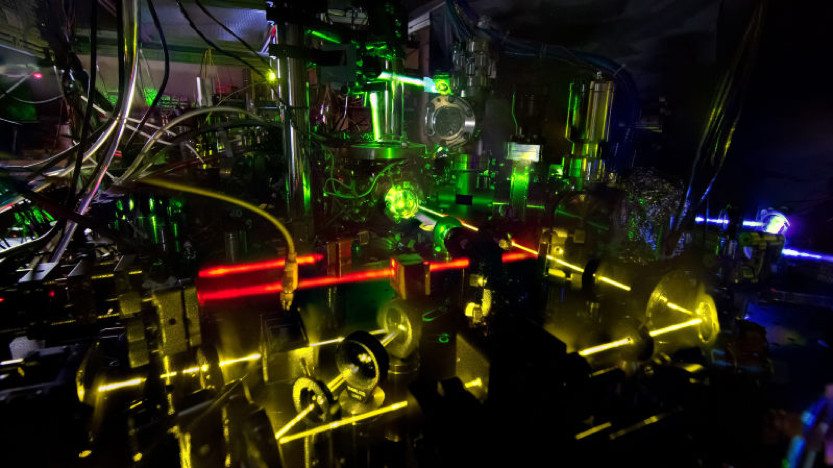月更替,斗转星移,时间见证了这一切的变化,而根据一项新的研究,物理学家已经创造出了非常精确的原子钟,它们可以测量时空本身的变形。
关键词:科普、译文、时空变化、原子钟

图片来源: N. Phillips/NIST
Physicists have created atomic clocks so precise that they can measure deformations in spacetime itself, according to new research.
根据一项新的研究,物理学家已经创造出了非常精确的原子钟,它们可以测量时空本身的变形。
We don't all experience time passing equally-time passes more slowly closer to something massive's gravitational pull, as famously theorized by Albert Einstein. And since gravity is typically interpreted as the way mass warps space itself, that means a precise-enough atomic clock could serve as a scientific tool for measuring how objects change the shape of their surrounding space.
我们并不是所有人都经历过时间的均等流逝 - 正如Albert Einstein著名的理论所言,时间在更接近某个大质量物体的引力时,流逝得更慢。由于引力通常被解释为质量扭曲空间本身的方式,这意味着一个足够精确的原子钟可以作为测量物体如何改变其周围空间形状的科学工具。
'We've reported measurements of two clocks that in principle exceed our ability to account for [this effect] across the surface of the Earth,' Andrew Ludlow, physicist at the National Institute of Standards and Technology in Boulder, Colorado, told Gizmodo.
科罗拉多州博尔德市,国家标准与技术研究所的物理学家Andrew Ludlow告诉Gizmodo说:'我们已经报告了两个时钟的测量结果,这些时钟原则上超出了我们在地球表面预期[此效应]的能力。'
Clocks are merely tools that measure how time passes by counting a repeating thing, be it a swinging pendulum or a vibrating atom. Optical lattice clocks, like the ones used in this study, work the same way-but not quite so simply.
时钟只是一种工具,它通过计算一个重复的东西来测量时间是如何流逝的,它可以是一个摆动的钟摆,也可以是一个振动的原子。与本研究中使用的光学晶格时钟一样,它们的工作原理是相同的 - 但并非如此简单。
Scientists first use lasers to set up an atom-trapping field, shaped like a row of cups. Thousands of ytterbium atoms populate each of the cups. If struck with a laser of exactly the right frequency, the electrons will jump between two energy levels, an incredibly large (nearly a quadrillion) but exact number of times per second. Once the laser is tuned to the perfect frequency to begin this oscillation, it passes to another component, called an optical frequency comb. This essentially serves as the gears of the clock, translating the laser light into a signal that can be used in electronics to create the tick.
科学家们首先使用激光来建立一个原子捕获场,形状像一排杯子。每个杯子里都有数千个镱原子。如果用频率完全正确的激光击中,电子将在两个能级之间跳跃,这个能级非常大(接近千万亿次),但每秒的次数却非常准确。一旦激光器被调谐到理想频率开始振荡,它就会传递到另一个组件,称为光频梳。这基本上用作时钟的齿轮,将激光转换成一个信号,可以用在电子产品中以产生滴答声。
Here, the researchers have essentially characterized the frequency to such a high precision that they can use it to precisely measure how gravity affects time, according to the paper published in Nature. A pair of ytterbium optical clocks accurately reported the ytterbium's transition frequency within 10-18 of the actual frequency, varying at most by 3.2 x 10-19, with a difference the two clocks' reported frequencies at around 10-19. Clocks with these accuracies would take longer than the age of the universe (13.8 billion years) to lose a second.
根据发表在《自然》杂志上的一篇论文,在这里,研究人员已经对频率进行了非常精确的描述,他们可以用它来精确地测量重力如何影响时间。一对镱光学时钟准确地报告了镱在实际频率的10-18范围内的转变频率,最多变化3.2 x,两个时钟的报告频率相差约为 。具有这种精确度的时钟需要比宇宙年龄(138亿年)更长的时间才能慢一秒钟。
But characterizing the clocks this well meant that the ytterbium clocks could detect how Earth's gravity had slowed time, accurately determining their location in the Earth's gravitational field to within a centimeter. This is better than the state-of-the-art Earth-measuring systems. Ludlow explained that the team hasn't compared the clocks in two separate locations, yet. A test like that would reveal the higher-altitude clock ticking faster, since the pull of Earth's gravity on an object actually decreases slightly as the object moves higher in altitude.
如此精确地刻画时钟的特性,意味着镱时钟可以探测到地球引力如何使时间变慢,从而精确地确定它们在地球重力场中的位置,误差不超过一厘米。这比最先进的地球测量系统要好。 Ludlow解释说,该团队还没有比较两个不同位置的时钟。这样的测试将会揭示更高海拔的时钟运行得更快,因为地球对物体的引力实际上会随着物体在更高的海拔移动而略有下降。
This is just the latest result from efforts around the world to create the best-ever atomic clock. But it's a fantastic development, said Andrei Derevianko, a theoretical physicist at the University of Nevada, Reno, who was not involved in this study but who has worked on the theory behind these clocks. He told Gizmodo that clocks with this level of accuracy are still searching for their 'killer application.'
这只是世界各地努力创造有史以来最好的原子钟的最新成果。但是,内华达大学雷诺分校的理论物理学家Andrei Derevianko说,这是一个非常棒的发展,他没有参与这项研究,但他一直致力于研究这些时钟背后的理论。他告诉Gizmodo,这种精确度的时钟仍然在寻找它们的'杀手级应用'。
But physicists have ideas for how to use them, especially when it comes to hunting for dark matter-stuff that our eyes and telescopes can't directly see, but which seems to exert some force of gravity throughout the universe. Perhaps these clocks could detect dark matter from the way its gravity alters spacetime. Maybe they can even detect ripples in spacetime called gravitational waves. Or maybe it's time to move atomic clocks into space, where they're less affected by local differences in the Earth's gravity. It's hard to say.
但物理学家对于如何使用它们有自己的想法,特别是在寻找暗物质的时候 - 我们的眼睛和望远镜无法直接看到它,但它似乎在整个宇宙中施加了某种引力。也许这些时钟可以通过暗物质的引力改变时空的方式来探测暗物质。也许它们甚至可以探测到时空中被称为引力波的涟漪。或者,也许是时候把原子钟移到太空中去了,在那里它们受到地球引力局部差异的影响较小。这很难说。
No, you can't wear this clock on your wrist or hang it on your wall-it's still a setup built on a lab table. But if you could, it would be pretty sick to be able to tell your friends that you were late because their local gravitational potential was too high.
不,你不能把这个时钟戴在手腕上或挂在墙上 - 它仍然是建在实验桌上的装置。但是如果可以的话,能告诉你的朋友,你迟到了是因为他们当地的引力太高了。
(责任编辑:周姚)

